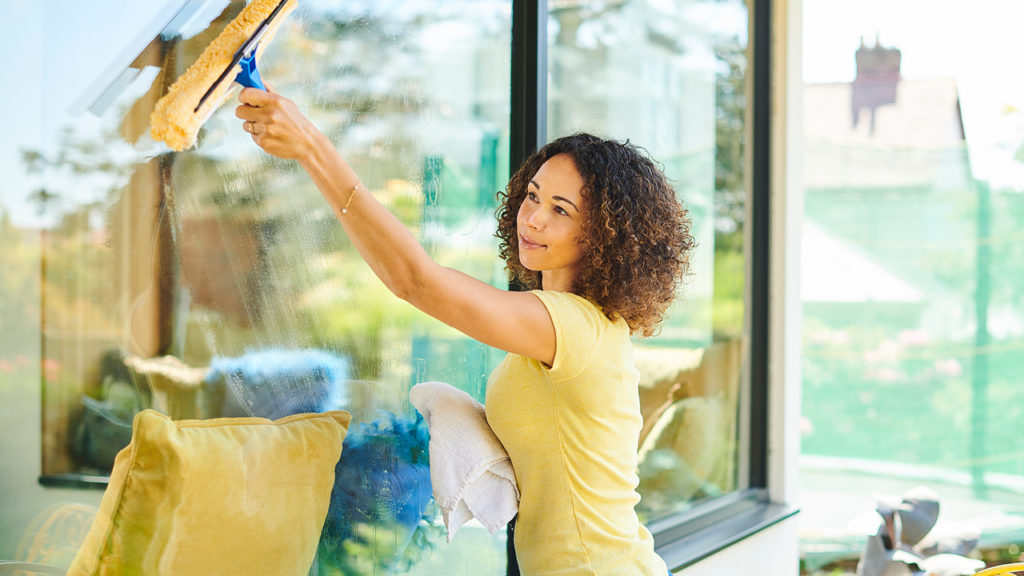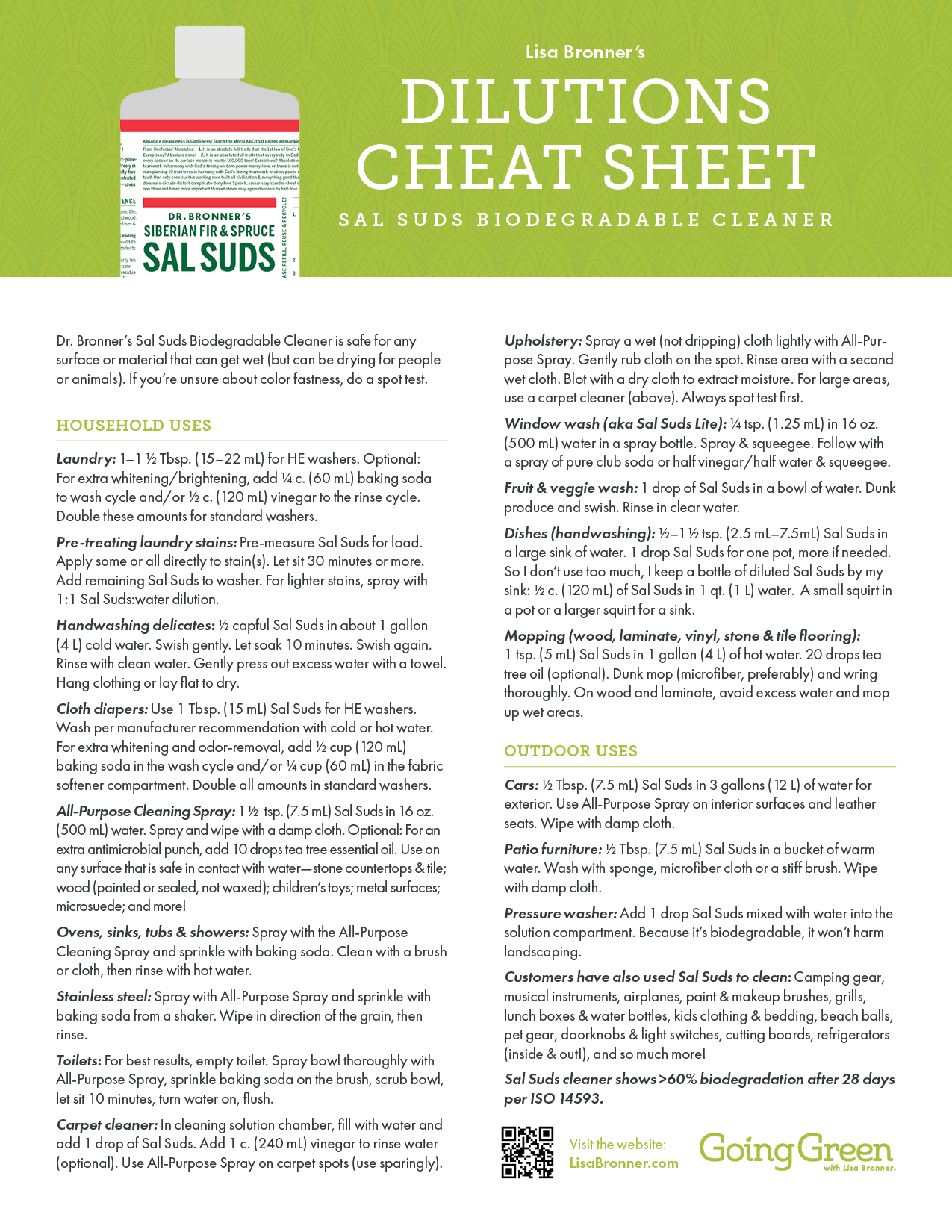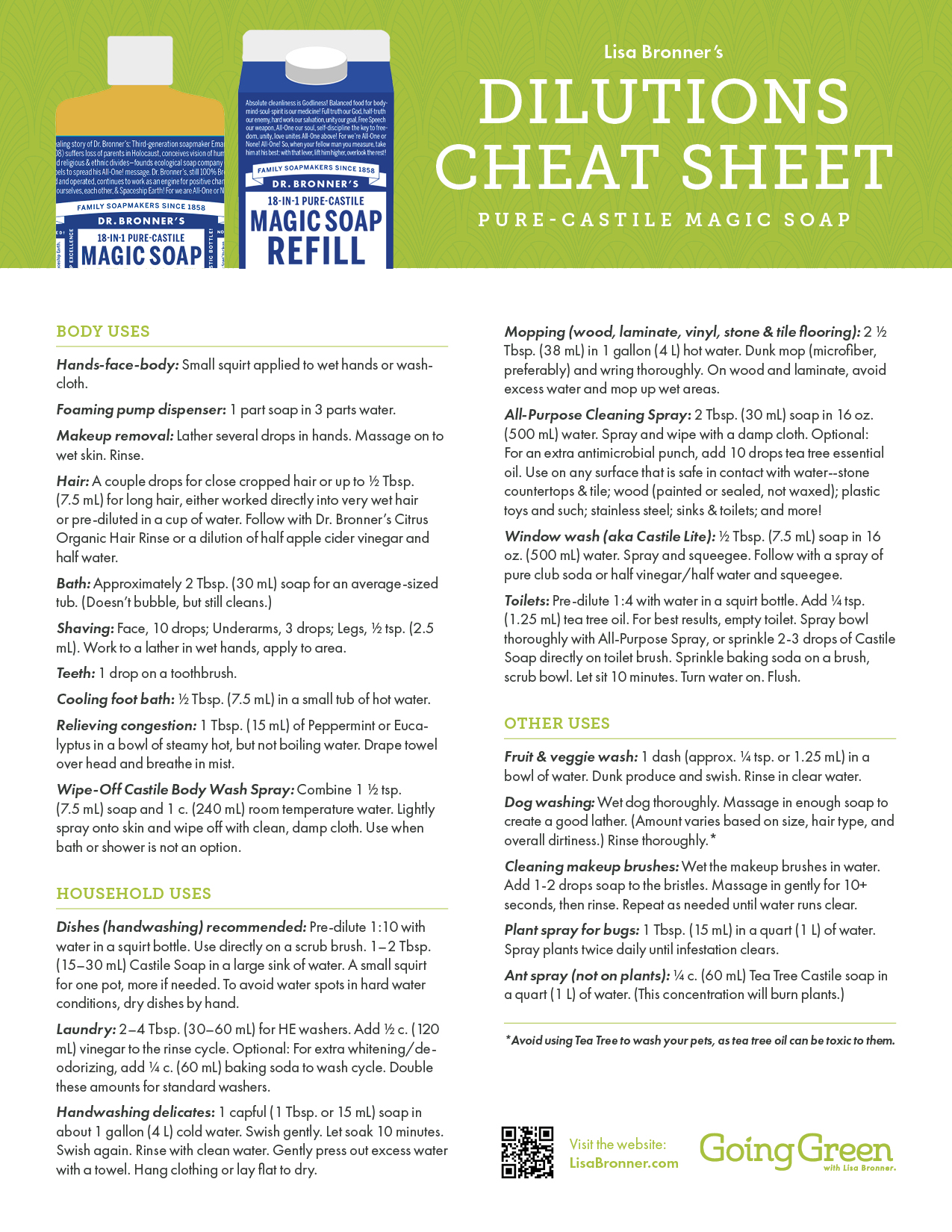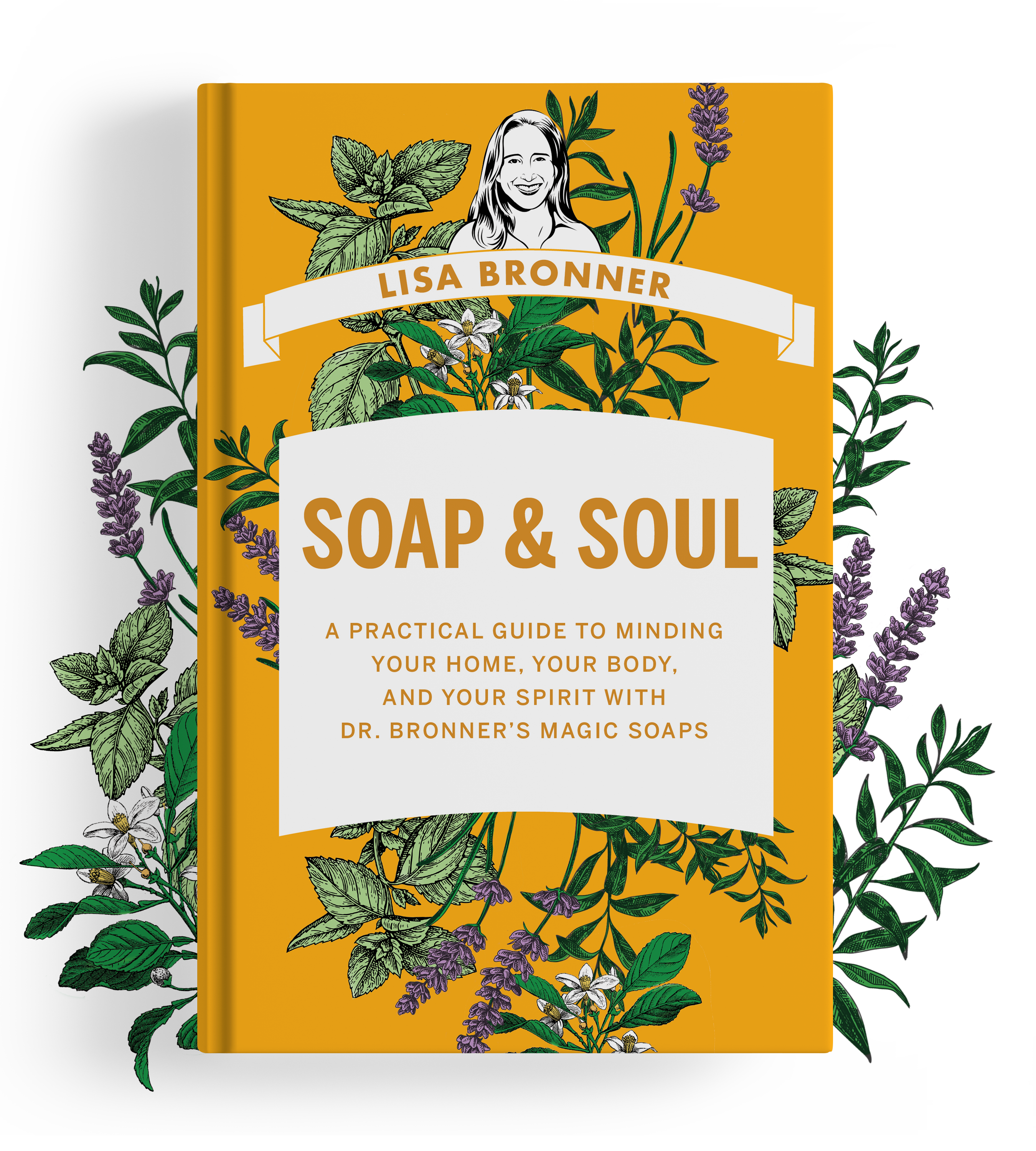
Windows, mirrors, glass shower doors. I like washing glass. Glass so blatantly shows its dirt, and cleaning it instantly brightens a room. It’s such a satisfying transformation. If I’m being honest, my love is partially due to the squeegee. How they glide across the glass, catching streaks and drips and spots, leaving a bright clean surface behind them. I even love the word! Squeegee, squeegee.
GIY* Glass Cleaner
Recipe #1: In a spray bottle, combine equal parts vinegar and water. That’s as complicated as this recipe gets.
- What kind of vinegar: Standard kitchen distilled white vinegar at a 5% dilution.
- What kind of water: Tap water is fine.
It is the acidity of vinegar (acetic acid to be precise) that will do your work for you.** The acid will lift light grease (which is what fingerprints are) and dissolve mineral deposits (which is what water spots are). Other light debris such as dust or soap splatters will be dissolved by the water itself. You do not need something fancy like apple cider vinegar (ACV). The sugars and other compounds in ACV will only get in the way. Glass is merciless in showing anything left behind, so there’s no reason to bring in other substances to wrestle with. Keep it simple and use plain white distilled vinegar.
Tap water is fine here because even if it is very hard—which means filled with calcium and magnesium—the acidity of the vinegar will keep the minerals dissolved. They will not deposit on the glass to become water spots.
Why not alcohol? If there’s another green ingredient that vies for vinegar in glass cleaner recommendations, it is alcohol—either rubbing alcohol (isopropyl) or even vodka (ethyl, ethanol). While alcohol does lift grease and disinfect (not usually the main need with glass, though), it does not have the acidity to dissolve minerals, which is what water spots and streaks often are. Plus, it’s more expensive, flammable, and poses more risk if misused. Save your vodka for your after-cleaning treat.
Recipe #2: Fill a spray bottle with Club Soda. Yep. That’s it.
Club Soda is also slightly acidic, which makes it an excellent glass cleaner. Use fresh, carbonated Club Soda. Once it has gone flat, which means the carbon dioxide has escaped, club soda is not as effective of a glass cleaner. I listed it second here since it’s a little less readily available or shelf stable as vinegar.
The wipe
What you use to wipe your windows is more important than what you spray. In fact, with a really excellent squeegee or rag, you can even get by with using only water in your spray bottle.
I may have mentioned, I like squeegees. But only high-quality ones with a flexible, durable black rubber edge. They cost more, but they actually work, so there’s that. As soon as a squeegee blade gets a nick or a hard spot, which happens very quickly with a plastic-y blade, they will bring only misery to your glass-cleaning life. If a high quality squeegee blade does degrade, you can change out the rubber and not have to replace the whole device. I will admit to one downside, which is the extra step of needing to lay a towel at the base of the glass to catch the drips as you squeegee down. I’m ok with that.
If you go with a cloth, use your best rag for glass. Don’t give me that look. We all have our best rags. The one we always reach for and get a little thrill of gladness to find it clean in the ragbag. It’s the right texture, the right size, the right thickness. It picks up a lot and leaves nothing behind. Glass is where its virtues will do the most good—catching every streak and smudge. I’m partial to microfiber because it is so absorbent and lint-free,*** but other great options are cloth diapers (Yep, from the baby section.), or simply cut up old soft cotton t-shirts.
My thoughts on using newsprint to wipe windows: I don’t subscribe to a printed paper, so this isn’t an option for me. However, even if I did, this isn’t what I’d use it for. They don’t make newspaper the way they used to. Newspaper of yore used to be thicker, which made it more durable for something like window washing. Today’s paper is very thin, which means it quickly becomes a useless wad. There’s also the risk that the ink will rub off onto painted window frames and sills. There has been some concern about the toxicity of the inks, and though they do contain chemicals that would be toxic to ingest (don’t wrap your food in newsprint), there’s little risk of this happening during window cleaning. All in all, there is not a hazard to using newspaper, and if it works for you, go for it. I wouldn’t go out of my way to use newsprint, though.
Green cleaning mirrors
Of the glass in our houses, mirrors are perhaps the easiest to clean. They don’t usually have soap scum as is common with shower doors or the build up of dirt and grime that windows can acquire. The GIY Glass Cleaner and your choice of wipe is all you need.
To clean mirrors:
- Spray mirrors with the GIY Glass Cleaner.
- If you’re using a squeegee, lay a towel across the base to catch drips.
- Wipe or squeegee the glass clean.
- Wipe the rims of the glass to catch any residual.
Green cleaning shower doors
The above glass cleaner works supremely well on mirrors, interior windows, and other glass that in the scheme of glass dirt, isn’t all that dirty. But when it comes to cleaning glass shower doors, usually what you’re dealing with is the dreaded soap scum.
Soap scum is not unrinsed soap, but rather is another type of mineral deposit. It forms when soap reacts with minerals in hard water. This mineral deposit goes by many names: soap scum, lime soap (Yes, I know I said soap scum isn’t soap, but lime soap is an incredibly misleading term because lime soap does not dissolve in water and is useless for washing. In fact, it is commercially produced as a water repellent for industrial purposes), or chemical names such as calcium/magnesium stearate/cocoate/olivate/palmate depending on what minerals are in the water and what fatty acids are in the soap.
If surfaces are left to air dry, this mineral deposit will be left behind and build up layers after multiple uses.
One way to minimize soap scum is to use a squeegee (yes!) on shower doors after each shower. I even squeegee my shower walls. Even though they don’t show soap scum as readily, I know it’s there. Plus, it gives me another reason to use my squeegee.
There are two ways to get rid of soap scum: chemically (dissolve it) or mechanically (scrub it off).
An acid will dissolve soap scum, and the vinegar-based GIY Glass Cleaner is acidic. This will work well if you have a light layer of soap scum and it is only on a durable surface, such as glass, porcelain, enamel, or acrylic. Because acids etch soft stone such as marble, limestone, and travertine, avoid using this glass cleaner on them, and if your shower doors are connected to such stones, lay a towel at the base of the doors to catch drips while you’re cleaning them.
Green cleaning soap scum with GIY Glass Cleaner
- Spray the glass cleaner on the surface.
- Let it sit for a few minutes, but not until it dries or else it will merely redeposit the minerals.
- Wipe or squeegee it off.
However, if your soap scum is quite built up, dissolving it with the glass cleaner might be a slow process.
Green cleaning soap scum with baking soda
- Spray the surface with the Castile Magic Soap or Sal Suds All-Purpose Spray (2 Tbsp. [30 mL] Castile Magic Soap OR 1½ tsp. [7.5 mL] in 16oz. [500 mL] water). Mostly this provides lubrication for the baking soda.
- Since most glass is vertical, you can’t sprinkle baking soda on it. Instead, get a stiff brush wet and dip it in baking soda and scrub the glass.
- Rinse.
- Dry with a squeegee or an absorbent lint-free cloth. You may not need to do anything else, but if you feel your glass isn’t quite sparkling, go ahead and use the GIY Glass Cleaner.
Green cleaning soap scum with GIY Soft Scrub
- Make a batch of GIY Soft Scrub, which contains baking soda.
- Squirt this on the glass or on your brush and scrub the glass.
- Rinse.
- Dry with a squeegee or an absorbent lint-free cloth. You may not need to do anything else, but if you feel your glass isn’t quite sparkling, go ahead and use the GIY Glass Cleaner.
Green cleaning windows
What we find on our windows is what exists in our air, which is a scary thought. Windows get a build up of dirt, grease from cooking vapors and outdoor pollutants, and other manner of air pollution which is what we’ve been breathing this whole time. That is a topic worth exploring, but I’ll stick to cleaning the glass for now.
The exterior of windows, and the interior if it’s been a while, will likely need a little more than the GIY Glass Cleaner to get them clean. They’re going to need a surfactant that will arrest dirt and grime and carry it away. In other words, they need Castile Soap or Sal Suds.
The GIY All-Purpose Spray mentioned above will work for cleaning the grime off of windows, but sometimes I find this dilution to be too strong and leaves too many suds for windows. In that case, I make a Lite version. (Why do we spell “Lite” that way?)
Lite Castile or Sal Suds window wash
- ½ Tbsp. (7.5 mL) Castile Magic Soap OR ¼ tsp. (1.25 mL) Sal Suds
- 16 oz. (500 m L) water
- Mix these in a spray bottle.
- Spray windows and wash with a wet (more than damp) cloth.
- Squeegee. (I really think squeegee-ing works best here.)
- If needed, follow up with the GIY Glass Cleaner.
Green cleaning screens
To get the most impact out of washing your windows, you also need to wash the screens. Screens catch a lot of debris, and you’ll be amazed at how much more light is able to come through them once they’re cleaned.
How to wash screens
- Remove your screens and lay them flat outside on a cement surface.
- In a wash bucket, combine ½ Tbsp. (7.5 mL) Sal Suds in 3 gallons (12 L) of water.
- Wet the screens with a hose.
- Dunk a long-handled brush or window/car scrubber in the bucket and scrub the screens.
- Flip the screens and scrub them again.
- Rinse well with the hose.
- Stand the screens against a wall to air dry.
- Reinstall screens.
I recommend only Sal Suds here and not the Castile Magic Soap because of the reaction I mentioned above between true soaps like the Castile Magic Soap and minerals. There are a lot of minerals outside and the Castile Magic Soap could leave soap scum on your driveway, which is unsightly. The Sal Suds, which is a detergent and doesn’t react with hard water, is also biodegradable, so any run-off is safe for grass and landscaping.
Other glass cleaning tips
- Save glass washing for your last cleaning task in a room so that no other wayward sprays will mar your streak-free shine.
- Wash glass top to bottom so you can catch any drips.
- Wipe the squeegee on a rag or towel after each pass to remove liquid and prevent drips.
- Wipe the rims of the glass last to catch residual spray or streaks.
- Look at the glass from the side to see if you caught all the streaks and spots.
- For double-sided glass (shower doors or windows), wipe/squeegee one side vertically and the other horizontally, so if there’s a streak, you’ll know which side it is on.
- Do not mix vinegar with either Castile Soap or Sal Suds. Vinegar and true soaps, such as Castile Magic Soap, react to form an oily substance. Vinegar cuts rather than boosts the cleaning ability of Sal Suds.
- Wait until the sun is not shining on windows to wash them. A cloudy day or the morning or evening are best.
- Use a razor blade (carefully!!) to remove paint or who-knows-what on glass. Take care not to scratch the glass or cut yourself.
* GIY: Green-It-Yourself–a term I made up!
** Vinegar & Disinfecting: While I’m on the subject of vinegar, I need to dispel a green cleaning myth, and I’m afraid I’m going to insult many people whose cleaning methods have been passed down through the generations. As I mentioned above, the acidity of vinegar will lift light grease and dissolve minerals. However, despite its history, vinegar is not a great option for general surface cleaning. First, it does not have the ability to bind to and carry away large amounts of grime, like a surfactant (soap or detergent) can. Second, as an acid, vinegar can cause etching into certain stones, resins, and acrylic, especially if higher concentrations of acetic acid are used, such as the 30% Cleaning Vinegar on the market. Third, while it does have some antimicrobial ability, vinegar does not disinfect at the concentrations and time commonly used for cleaning. One study found a 10% acetic acid (standard distilled vinegar is 5% acetic acid) was broadly effective against microbes. Another study found 6% acetic acid solution effective against tuberculosis after 30 minutes of exposure—both a far higher concentration and a far longer exposure time than we give surfaces during cleaning. Even if you adhered to these concentration or time commitments, you’d end up damaging your surfaces with the etching power of the acid. Instead, utilize vinegar for glass cleaning, for laundry softening, for carpet rinsing, but not for surface disinfection.
*** Washing Microfiber: For the first seven washes, consider washing microfiber in the GuppyFriend, which catches any sluffed off nanoparticles and curtails microplastic pollution.
Further reading
- The Low Cost of Green Cleaning
- Cleaning Stainless Steel With Dr. Bronner’s
- GIY All-Purpose Cleaning Spray
Sal Suds cleaner shows >60% biodegradation after 28 days per ISO 14593.
This use and many more are in my book, Soap & Soul: A Practical Guide to Minding Your Home, Your Body, and Your Spirit with Dr. Bronner’s Magic Soaps, available now in hardback on DrBronner.com or at your favorite bookseller, and as an eBook and audiobook (read by me!) from wherever you download or listen.





Thank you for all of the great tips!! 🫶🏽
Thank you so much for educating us with green living matter of facts, advice, recipes and suggestions. I have tried too many “eco-friendly” cleaning methods (and products) and was about to give up! You had me at “you don’t need something fancy here”. I especially appreciate the info about vinegar (& Alcohol too), I’m almost certain I did some unnecessary damage by using a high concentration of “cleaning” vinegar in the past. Busting that myth is my Aha and D’oh! moment and now I’m stoked about “GIY”.
I’m so glad, Laura!
Lisa your insightful guide to green cleaning offers a refreshing perspective on maintaining a sparkling home without harming the environment. Your emphasis on simplicity and effectiveness resonates deeply with those seeking sustainable solutions. One thing that is worth considering when cleaning windows is to wait for a cloudy day or choose early morning or evening hours to avoid streaks caused by direct sunlight. With these practical tips and DIY recipes, it is possible to achieve a pristine home and caring for the planet at the same time. Thank you! I’ll be sure to share with my team over at https://ultrashine.co.nz/.
Hi Lisa! Big fan. I’ve always used your castille soap but recently bought my first bottle of sal suds. I didn’t know it was actually going to smell to darn good! My question, what do you suggest we use to clean our TV, computer monitors and phone screens?
Hi Rachel – I’m so glad the soap and Suds have been such a help to you! If your screens just have dust on them, I’d recommend a slightly damp microfiber cloth. For fingerprints on touch screens, spray a damp cloth with a bit of the All Purpose Spray made with Sal Suds. Use the cloth to wipe down the screens.
I’ve looked for a squeegee like the one you show here with a nice big scrubbing head and a strong rubber scraper. But I can’t find one that looks like it. What brand is that? Or can you recommend a good brand? Thanks!
Hi Bonnie- I’m sorry, I don’t know where that’s from nor have a brand to recommend. I think a home improvement store would have a selection though. They are often called a squeegee scrubber combo.
We tried this professional window cleaners’s method of cleaning screens and it was amazing results and fast! Highly recommend trying it with Sal suds. (He uses Dawn dish liquid). https://m.youtube.com/watch?v=SRv0wviEshk
Hi Diane- Yes, I think Sal Suds would work well with this technique too.
Great post and thank you for taking the time to put this together! Do you happen to have a link to a great Squeegee?
Hi James- I’m glad this helpful! I don’t have a link or brand to share, but a home improvement store generally provides the most durable options.
What do you recommend for cleaning interior of car windows that get foggy from using the fan? Will the white vinegar and water solution work?
Hi Eric- If your window is just a little dirty, you can go straight to the vinegar/water dilution. If it needs a little more, use the Castile or Sal Suds Lite spray first.
Do you have any squeegee recommendations or info on what constitutes one being high quality?
Hi there- Home improvement stores typically have the most durable offerings. Look for a black rubber blade with smooth edges.
Thank you for all of your suggestions. I especially liked your warning of etching caused by certain products.
This has been helpful.